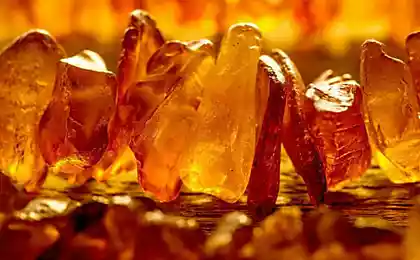1088
In search of succinic legend
Svetlana Smirnova
There are dozens of versions, where and how can the gulf Amber Room, and yet there is no certainty that it will find any.
Over the short-lived across the history of the 65 years that the Amber Room is the number of "missing", hundreds of people have sought to uncover the mystery of her secluded shelter. Some dedicated search for the legendary room service hours, others - private holidays and vacations. There were those who considered the searches "amber ghost" business of his life, and there were even those who put their lives on the altar of searches. There is not a figure of speech. "The death under mysterious circumstances" - not the rare "diagnosis" of all ranks for search engines. Others seekers immediately begin to believe that those who are not lucky, do not except too close to unlocking the secrets of amber. From this exalted man is easy to conclude that, in parallel with people who want to re-known room was the light of God, there are other people whose efforts are aimed at achieving the opposite goal. Because if these people do not have, you have to believe in the existence of supernatural forces, although ghosts confusing and contradictory "case of the Amber Room" (in which anything can are mixed!) Until they appear. Or spitpoisons prevent or ghosts, no middle ground - perhaps many rozyskniki misunderstood "the law of the excluded middle» (tertium non datur). Maybe, just well hidden?
Home path and change of apartments
Traces of the "eighth wonder of the world", as called Amber Room, lost in Königsberg (now Kaliningrad) in spring 1945. But before we push down on that date and begin to walk on the trail branched versions of the current seat of the Amber Room, it is necessary to talk about how she actually came to East Prussia and why the Germans called the miracle of their Russian national treasure.
The famous Baltic amber - a fossilized resin, which is used for the production of jewelry and jewelry, as well as in pharmaceuticals. Photo: Vilor / Shutterstock Images

In the XVII century in Königsberg there was a guild of amber craftsmen Affairs. Among the many items made of "combustible stone" (as it is sometimes called), they were created richly decorated with engravings and sculptures of three frames of amber mirrors. Perhaps these frames and prompted Andreas Schlüter (Andreas Schlüter, 1664-1714), architect and sculptor as well as a person close to the Prussian royal court, the creation of the Cabinet of the Governor, the walls of which are lined in amber. In addition, Schluter know how large reserves of "combustible stone" in the royal treasuries, and realized that the problems with the lack of material will not.
The prospect of becoming the owner of a unique Cabinet liking Frederick I, and here in 1701 in a special open workshop work started. The task before the grand masters was - not only oblitsevat amber fairly large areas, but also to decorate their amber reliefs, engravings, miniature carvings. Apparently, so 12 years after the start of work at the time of the death of Frederick I, the Cabinet was not yet ready. However, prior to the completion it was not much, but the successor to Friedrich who despises luxury and extravagance Frederick William I, the device Amber Cabinet has not approved, funding for the work stopped, and the master dismissed. Amber panels have taken their place in the storerooms, where they got only 3 years later. We got on the orders of the king, in order to give to Peter I, who arrived on a visit to Berlin. The Russian Tsar was not in debt and in turn presented to the King of Prussia 55 grenadiers. But the unfinished Amber Cabinet ordered to pack carefully and with proper precautions to ship in St. Petersburg.
The main decoration of the royal palace was the Amber Room at Elizabeth. Add a gift of Prussian King in the Winter Palace Empress commissioned Bartolomeo Rastrelli. It was not easy - in fact the original amber panels were created for entirely different premises - now had to fit them into a new architectural space, making additions and changes to restore it, on what had time to leave his mark time, buy the missing amber. After 10 years - in 1755 - Elizabeth visited another idea: move the Amber Room from the Winter in a specially crafted ceremonial hall of the Catherine Palace in Tsarskoye Selo, which was done with the help of "76 guards, athletes and akkuratistov." Again Rastrelli took the now familiar job placement panels. Over time, the Amber Room began to accumulate favors of "sun stone" (the so-called amber Slavs) - hourglass, snuff, salt shakers, cups, caskets, checkers, chess, inkstand.
The second move
During the October Revolution, the Amber Room happily escaped the dismantling and / or sales abroad (so did "gourmet junk"). But in 1941 it was less fortunate - in the rear, along with other museum quality amber panels was not sent. Why is that? This is a question to which there is no direct answer. But there are versions (in the "case of the Amber Room" in general are many versions).
Grenadier Shverid Redivanoff from Moscow. One of those fifty-five "giant grenadiers growth", which Peter the Great sent to Berlin in exchange for the Amber Room

The first version, idealistic. In June 1941, few people thought that the German troops reach Pushkin (in 1918 Tsarskoye Selo was renamed the Children's Village, and in 1937 - in Pushkin), the outbreak of war in the Catherine Palace took measures to protect the exhibits from bombs, shells and fires caused by them. For this exhibit's most valuable were transferred to the basement, the palace windows hammered boards, all the rooms have put boxes with sand and water barrels. As additional tanks used large vase. But the Germans and their allies were in Pushkin in the middle of September 1941.
Version two, banal. Did not have time! A few museum workers worked day and night, but pack all the valuable artifacts - and a huge number of fragile, small or bulky items that require special temperature and humidity conditions of storage (and hence the special packaging material) - were unable to.
Third version, "restricted to travel abroad." The Amber Room was subjected to periodic restorations since the time of Rastrelli. In 1941 it was planned regular maintenance work on a masterpiece in good condition (this time scale), but they were not carried out. As a result, when trying to remove the panels from the walls, amber mosaic rain drizzled onto the floor (panels dried up, and glue "exhausted"). In order to avoid shedding, we try to stick amber thin paper, but it did not help. There was a dilemma: either to destroy "the eighth wonder of the world" trying to evacuate, or leave it in place by covering with gauze covering covers made of cotton and blocking shields. We chose the latter.
Restoration workshop where painstakingly recreated Amber Room. Photos (Creative Commons license): Robert Breuer
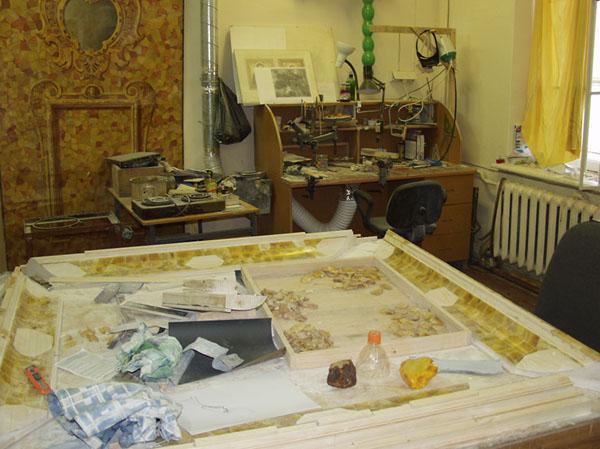
But in the latest version can be seen significant controversy - something the Germans were able to take the room! And he did it the same fall of 1941! And in 1942 established the amber panels in the Royal Castle of Königsberg (East Prussia), is open to visitors - especially important for the first and then for everyone. It turns out that remove the panel from the wall without destroying masterpiece still possible. Direct confirmation of this are 5 pictures with views of the room, made the new owners of the "eighth wonder of the world" in 1942 for the magazine "Pantheon". The pictures can be seen that the Amber Room was exhibited not all, moreover, it has lost one of the mosaics and some elements of the decor, but it is still there.
Again at home
The original Amber Room, as well as thousands of other artifacts from museums in Kiev, Minsk, Moscow and Leningrad, was to go to Hitler's favorite city of Linz. There's "an outstanding expert on the art of" planned to open a unique museum - the largest on the planet. In addition, Hitler was very fond of amber and believed in a variety of its exotic properties. But as it turned out, two more people - the director of art collections of the Museum of Königsberg, doctor of art by Alfred Rode and governor (in fact, the owner) of East Prussia, Erich Koch - adored Amber and Amber Room in particular, is not less than the Fuhrer. Koch launched a campaign to ensure that the masterpiece of "combustible stone", produced in Prussia, "the eighth wonder of the world", demanding the restoration under the supervision of the best specialists in amber, remained on the "historic homeland" - in Koenigsberg. And got his.
It is not difficult to imagine how happy this circumstance, the author of "bible" for specialists of "combustible stone" ("Amber - German material"), a person calling a masterpiece of Catherine Palace national pride in Germany and wants to return it "to the bosom of Mother Prussia" Alfred Rhodes - according to contemporaries, this "amber maniac." Now Bernshtayntsimmer (Bernsteinzimmer - so-called Amber Room in German) handed him "for proper storage».
It looks like the new Amber Room. The main difference - the color. They say old room to the beginning of the war was already quite dark - on time and a special composition, which was coated with amber, so it does not crumble. Reconstituted room as the old original, has a glowing golden hue.
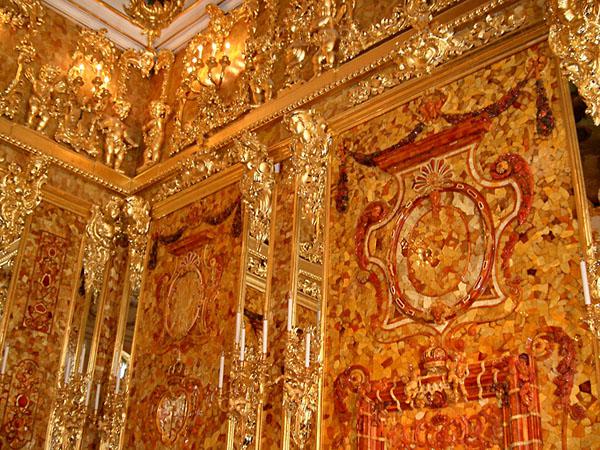
Rode Bernshtayntsimmer placed in one of the rooms of the Royal Castle and, as already noted, was showing its visitors. However, in the late summer of 1944, he was forced to dismantle the room, folded panel boxes and hide them in the basement of the citadel. The reason for that was the air raids of English and American aviation. The bombing turned the Royal Castle, whose walls kept the memories of the Knights of the Teutonic Order in ruins, and the fire ruined castle collected works of art. Apparently, in the flame of the fire and burned part of the Amber Room.
This fact was the basis for the version according to which "the eighth wonder of the world" were killed in the fire to look for it makes no sense. Eyewitnesses recall how in the walls of the dilapidated castle pale and lost Alfred Rode allegedly looked on honey-colored "puddle", from which protruded the charred pieces of wood, and sadly sighed: "This is all that remains of the Amber Room».
But other evidence preserved. Rode closest aide, Professor Gerhard Strauss, later recalled: "A few days after the terrible bombing ... I went to the castle and there again saw Dr. Rohde and his Bernshtayntsimmer. The boxes in which the room was packed, standing in the courtyard of the castle. Worried Rohde said that he took them out of the basement, so they have cooled. The castle burned after all, and in the cellars rose dangerous for wood temperature. "We have to hide, - muttered Rode - to take away, to save room, but I do not give permission. But I know where to hide Bernshtayntsimmer ».
Amber panels were made in Prussia, and therefore a single-headed eagle, the Prussian. Eagle, in the design of their shoulders having a pagan symbol of the power of the god Thor (three-bladed crosses, by the way - a favorite motif of decorative art Prussians X-XI centuries), - the last echo of the Viking Age. Photos (Creative Commons license): K.Hurley
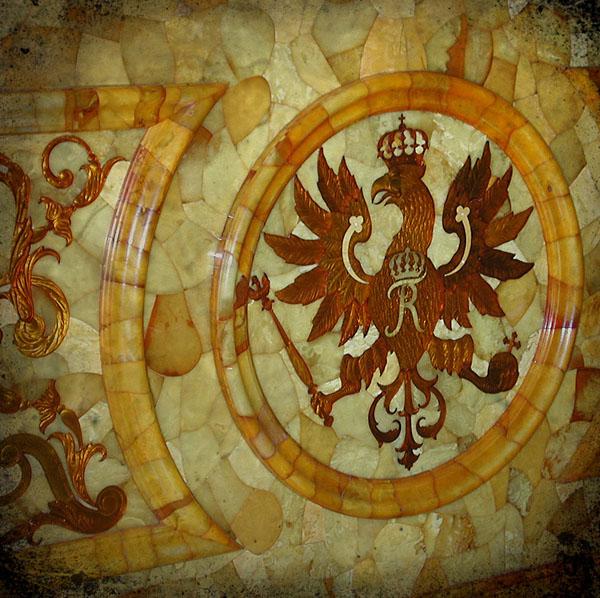
In addition, preserved letter of Alfred Rode of 2 September 1944, in which he reported to Berlin in the Kaiser-Friedrich-Muzeum (Kaiser-Friedrich-Museum, now called Bode Museum): "Despite the complete destruction of the Koenigsberg castle, measures air defense, which we took were justified. The Amber Room, with the exception of the six elements basement, safe and sound ».
However, the Amber Room survived the bombardment, only to disappear. In March-April 1945 to pack and evacuate the museum values - their own and others - have become Germans: Allied troops were advancing. Apparently, the Amber Room was hidden or taken out by the stakeholders, among other treasures. But where?
The road into the unknown
This question has given a detailed response to the German Georg Stein, who has spent much of his life searching (and nebezrezultatnomu!) Works of art, the Nazis removed from the former Soviet Union. Decades Stein carefully studied the documents relating to Bernshtayntsimmer, interviewed witnesses and participants of the events of the last months of the war, numerous hypotheses tested (and left the archives of hundred thousand valuable documents relating to the Amber Room).
The fate of George Stein was tragic. For a long time researchers are abusive or threatening letters, like this:
Highly honored pig Stein. With all of these Germans were disgusted watching the nonsense that you keep doing ...
And in 1987 he was found dead. The police said it was suicide. But friends Stein claimed that just before the death of the researcher said that finally came close to solving the mystery of the Amber Room - so what would cause him to commit suicide on the verge of success? Puzzling and method of suicide: it turned out that Stein first-inflicted several wounds (on the body showed signs of them), and then ripped open the stomach.
City Elling, Germany, April 24, 1945. One of the detected advancing units of the American Army warehouse, trapped by the Nazis prepared for export values. Photo: from the collection of NARA
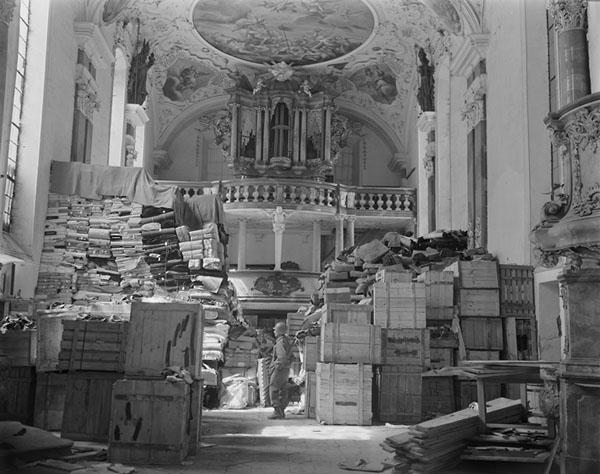
So it was Stein, summing up years of searching, put forward four main versions possible whereabouts of the Amber Room.
• The first version, "Konigsberg": Bernshtayntsimmer remained in Koenigsberg and the surrounding area.
• The second version, "Sea": The Amber Room has sunk with the ship in which it tried to take out from East Prussia.
• the third version, "Mines": Bernshtayntsimmer safely dovezli (sea or land) to Germany and hid in the mines of Saxony.
• Version Four, "overseas": Arriving at one of the ports in Germany, the Amber Room was intercepted by the Americans and went to the transatlantic voyage.
The first version as if it gives some hope that you can find the Amber Room: it is necessary to try, if necessary, "on the stones" moved the current territory of the Kaliningrad region (former Koenigsberg and the surrounding area). But not all so simple!
In the Middle Ages Koenigsberg rebuilt as a military strongpoint. The castles and fortifications of Konigsberg, there were more than a thousand secluded spaces adapted to store something else. (Alfred Rode knew the location of the basement of the Royal Castle that until other castles and estates of East Prussia, it is known that since 1944 Rode enter into correspondence with their owners - for example, Count von Schwerin, Prince Dona Shlobitten - for accommodation works of art in a secret room of their possessions).
From 1944 to medieval shelters Konigsberg began to add new - modern. They were built by order of Erich Koch. The "boss" of East Prussia knew that the arrival of the Soviet army in Königsberg - now only a matter of time, therefore solved the issue with the disposal of art treasures (the Nazis did not think to part with what is called "cultural tribute"). Bomb shelters, underground communications, military dungeons, secret bunkers - under construction caches used everything that was possible.
Gen. Dwight D. Eisenhower, the supreme commander of the Allied forces, examining objects of art looted by the Germans, who had been hidden in a salt mine Merkers. Photo: Lt. Moore, from the collection of NARA
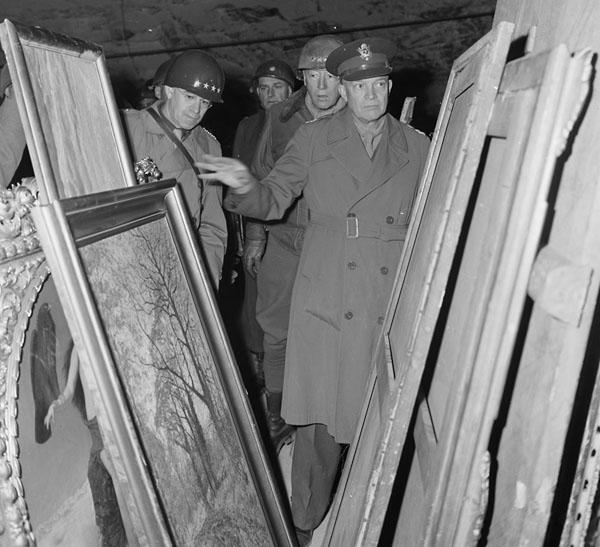
But back to the versions. Over time, the four versions of George Stein found the so-called subversion and were specified versioned object (promising in terms of the search locks, bunkers, mines, landfills). Today the total number of versioned objects in the hundreds. Amber Room offer search in Thuringia (for example, in the dungeons of the secret Nazi object Olga III), in Saxony (eg mine Vittekind), in the basement of the castle in East and West Prussia and Poland, in the mines of northern Bohemia and Silesia, at the bottom of Ladoga lakes and forts in California. And on ... elite suburban dachas. It is not versioned object, and stand-alone version (number five) that the Amber Room was returned to the territory of the former Soviet Union immediately after the capture of Prussia and it was lost in the vast apartment party leadership. However, it is not clear why then spend money and energy on searching for the room, and on its recovery (in 2003 the new Amber Room had been started).
However, any version, even the most unexpected, has a right to exist exactly as long as the Amber Room is found. HERE
Source:
There are dozens of versions, where and how can the gulf Amber Room, and yet there is no certainty that it will find any.
Over the short-lived across the history of the 65 years that the Amber Room is the number of "missing", hundreds of people have sought to uncover the mystery of her secluded shelter. Some dedicated search for the legendary room service hours, others - private holidays and vacations. There were those who considered the searches "amber ghost" business of his life, and there were even those who put their lives on the altar of searches. There is not a figure of speech. "The death under mysterious circumstances" - not the rare "diagnosis" of all ranks for search engines. Others seekers immediately begin to believe that those who are not lucky, do not except too close to unlocking the secrets of amber. From this exalted man is easy to conclude that, in parallel with people who want to re-known room was the light of God, there are other people whose efforts are aimed at achieving the opposite goal. Because if these people do not have, you have to believe in the existence of supernatural forces, although ghosts confusing and contradictory "case of the Amber Room" (in which anything can are mixed!) Until they appear. Or spitpoisons prevent or ghosts, no middle ground - perhaps many rozyskniki misunderstood "the law of the excluded middle» (tertium non datur). Maybe, just well hidden?
Home path and change of apartments
Traces of the "eighth wonder of the world", as called Amber Room, lost in Königsberg (now Kaliningrad) in spring 1945. But before we push down on that date and begin to walk on the trail branched versions of the current seat of the Amber Room, it is necessary to talk about how she actually came to East Prussia and why the Germans called the miracle of their Russian national treasure.
The famous Baltic amber - a fossilized resin, which is used for the production of jewelry and jewelry, as well as in pharmaceuticals. Photo: Vilor / Shutterstock Images

In the XVII century in Königsberg there was a guild of amber craftsmen Affairs. Among the many items made of "combustible stone" (as it is sometimes called), they were created richly decorated with engravings and sculptures of three frames of amber mirrors. Perhaps these frames and prompted Andreas Schlüter (Andreas Schlüter, 1664-1714), architect and sculptor as well as a person close to the Prussian royal court, the creation of the Cabinet of the Governor, the walls of which are lined in amber. In addition, Schluter know how large reserves of "combustible stone" in the royal treasuries, and realized that the problems with the lack of material will not.
The prospect of becoming the owner of a unique Cabinet liking Frederick I, and here in 1701 in a special open workshop work started. The task before the grand masters was - not only oblitsevat amber fairly large areas, but also to decorate their amber reliefs, engravings, miniature carvings. Apparently, so 12 years after the start of work at the time of the death of Frederick I, the Cabinet was not yet ready. However, prior to the completion it was not much, but the successor to Friedrich who despises luxury and extravagance Frederick William I, the device Amber Cabinet has not approved, funding for the work stopped, and the master dismissed. Amber panels have taken their place in the storerooms, where they got only 3 years later. We got on the orders of the king, in order to give to Peter I, who arrived on a visit to Berlin. The Russian Tsar was not in debt and in turn presented to the King of Prussia 55 grenadiers. But the unfinished Amber Cabinet ordered to pack carefully and with proper precautions to ship in St. Petersburg.
The main decoration of the royal palace was the Amber Room at Elizabeth. Add a gift of Prussian King in the Winter Palace Empress commissioned Bartolomeo Rastrelli. It was not easy - in fact the original amber panels were created for entirely different premises - now had to fit them into a new architectural space, making additions and changes to restore it, on what had time to leave his mark time, buy the missing amber. After 10 years - in 1755 - Elizabeth visited another idea: move the Amber Room from the Winter in a specially crafted ceremonial hall of the Catherine Palace in Tsarskoye Selo, which was done with the help of "76 guards, athletes and akkuratistov." Again Rastrelli took the now familiar job placement panels. Over time, the Amber Room began to accumulate favors of "sun stone" (the so-called amber Slavs) - hourglass, snuff, salt shakers, cups, caskets, checkers, chess, inkstand.
The second move
During the October Revolution, the Amber Room happily escaped the dismantling and / or sales abroad (so did "gourmet junk"). But in 1941 it was less fortunate - in the rear, along with other museum quality amber panels was not sent. Why is that? This is a question to which there is no direct answer. But there are versions (in the "case of the Amber Room" in general are many versions).
Grenadier Shverid Redivanoff from Moscow. One of those fifty-five "giant grenadiers growth", which Peter the Great sent to Berlin in exchange for the Amber Room

The first version, idealistic. In June 1941, few people thought that the German troops reach Pushkin (in 1918 Tsarskoye Selo was renamed the Children's Village, and in 1937 - in Pushkin), the outbreak of war in the Catherine Palace took measures to protect the exhibits from bombs, shells and fires caused by them. For this exhibit's most valuable were transferred to the basement, the palace windows hammered boards, all the rooms have put boxes with sand and water barrels. As additional tanks used large vase. But the Germans and their allies were in Pushkin in the middle of September 1941.
Version two, banal. Did not have time! A few museum workers worked day and night, but pack all the valuable artifacts - and a huge number of fragile, small or bulky items that require special temperature and humidity conditions of storage (and hence the special packaging material) - were unable to.
Third version, "restricted to travel abroad." The Amber Room was subjected to periodic restorations since the time of Rastrelli. In 1941 it was planned regular maintenance work on a masterpiece in good condition (this time scale), but they were not carried out. As a result, when trying to remove the panels from the walls, amber mosaic rain drizzled onto the floor (panels dried up, and glue "exhausted"). In order to avoid shedding, we try to stick amber thin paper, but it did not help. There was a dilemma: either to destroy "the eighth wonder of the world" trying to evacuate, or leave it in place by covering with gauze covering covers made of cotton and blocking shields. We chose the latter.
Restoration workshop where painstakingly recreated Amber Room. Photos (Creative Commons license): Robert Breuer

But in the latest version can be seen significant controversy - something the Germans were able to take the room! And he did it the same fall of 1941! And in 1942 established the amber panels in the Royal Castle of Königsberg (East Prussia), is open to visitors - especially important for the first and then for everyone. It turns out that remove the panel from the wall without destroying masterpiece still possible. Direct confirmation of this are 5 pictures with views of the room, made the new owners of the "eighth wonder of the world" in 1942 for the magazine "Pantheon". The pictures can be seen that the Amber Room was exhibited not all, moreover, it has lost one of the mosaics and some elements of the decor, but it is still there.
Again at home
The original Amber Room, as well as thousands of other artifacts from museums in Kiev, Minsk, Moscow and Leningrad, was to go to Hitler's favorite city of Linz. There's "an outstanding expert on the art of" planned to open a unique museum - the largest on the planet. In addition, Hitler was very fond of amber and believed in a variety of its exotic properties. But as it turned out, two more people - the director of art collections of the Museum of Königsberg, doctor of art by Alfred Rode and governor (in fact, the owner) of East Prussia, Erich Koch - adored Amber and Amber Room in particular, is not less than the Fuhrer. Koch launched a campaign to ensure that the masterpiece of "combustible stone", produced in Prussia, "the eighth wonder of the world", demanding the restoration under the supervision of the best specialists in amber, remained on the "historic homeland" - in Koenigsberg. And got his.
It is not difficult to imagine how happy this circumstance, the author of "bible" for specialists of "combustible stone" ("Amber - German material"), a person calling a masterpiece of Catherine Palace national pride in Germany and wants to return it "to the bosom of Mother Prussia" Alfred Rhodes - according to contemporaries, this "amber maniac." Now Bernshtayntsimmer (Bernsteinzimmer - so-called Amber Room in German) handed him "for proper storage».
It looks like the new Amber Room. The main difference - the color. They say old room to the beginning of the war was already quite dark - on time and a special composition, which was coated with amber, so it does not crumble. Reconstituted room as the old original, has a glowing golden hue.

Rode Bernshtayntsimmer placed in one of the rooms of the Royal Castle and, as already noted, was showing its visitors. However, in the late summer of 1944, he was forced to dismantle the room, folded panel boxes and hide them in the basement of the citadel. The reason for that was the air raids of English and American aviation. The bombing turned the Royal Castle, whose walls kept the memories of the Knights of the Teutonic Order in ruins, and the fire ruined castle collected works of art. Apparently, in the flame of the fire and burned part of the Amber Room.
This fact was the basis for the version according to which "the eighth wonder of the world" were killed in the fire to look for it makes no sense. Eyewitnesses recall how in the walls of the dilapidated castle pale and lost Alfred Rode allegedly looked on honey-colored "puddle", from which protruded the charred pieces of wood, and sadly sighed: "This is all that remains of the Amber Room».
But other evidence preserved. Rode closest aide, Professor Gerhard Strauss, later recalled: "A few days after the terrible bombing ... I went to the castle and there again saw Dr. Rohde and his Bernshtayntsimmer. The boxes in which the room was packed, standing in the courtyard of the castle. Worried Rohde said that he took them out of the basement, so they have cooled. The castle burned after all, and in the cellars rose dangerous for wood temperature. "We have to hide, - muttered Rode - to take away, to save room, but I do not give permission. But I know where to hide Bernshtayntsimmer ».
Amber panels were made in Prussia, and therefore a single-headed eagle, the Prussian. Eagle, in the design of their shoulders having a pagan symbol of the power of the god Thor (three-bladed crosses, by the way - a favorite motif of decorative art Prussians X-XI centuries), - the last echo of the Viking Age. Photos (Creative Commons license): K.Hurley

In addition, preserved letter of Alfred Rode of 2 September 1944, in which he reported to Berlin in the Kaiser-Friedrich-Muzeum (Kaiser-Friedrich-Museum, now called Bode Museum): "Despite the complete destruction of the Koenigsberg castle, measures air defense, which we took were justified. The Amber Room, with the exception of the six elements basement, safe and sound ».
However, the Amber Room survived the bombardment, only to disappear. In March-April 1945 to pack and evacuate the museum values - their own and others - have become Germans: Allied troops were advancing. Apparently, the Amber Room was hidden or taken out by the stakeholders, among other treasures. But where?
The road into the unknown
This question has given a detailed response to the German Georg Stein, who has spent much of his life searching (and nebezrezultatnomu!) Works of art, the Nazis removed from the former Soviet Union. Decades Stein carefully studied the documents relating to Bernshtayntsimmer, interviewed witnesses and participants of the events of the last months of the war, numerous hypotheses tested (and left the archives of hundred thousand valuable documents relating to the Amber Room).
The fate of George Stein was tragic. For a long time researchers are abusive or threatening letters, like this:
Highly honored pig Stein. With all of these Germans were disgusted watching the nonsense that you keep doing ...
And in 1987 he was found dead. The police said it was suicide. But friends Stein claimed that just before the death of the researcher said that finally came close to solving the mystery of the Amber Room - so what would cause him to commit suicide on the verge of success? Puzzling and method of suicide: it turned out that Stein first-inflicted several wounds (on the body showed signs of them), and then ripped open the stomach.
City Elling, Germany, April 24, 1945. One of the detected advancing units of the American Army warehouse, trapped by the Nazis prepared for export values. Photo: from the collection of NARA

So it was Stein, summing up years of searching, put forward four main versions possible whereabouts of the Amber Room.
• The first version, "Konigsberg": Bernshtayntsimmer remained in Koenigsberg and the surrounding area.
• The second version, "Sea": The Amber Room has sunk with the ship in which it tried to take out from East Prussia.
• the third version, "Mines": Bernshtayntsimmer safely dovezli (sea or land) to Germany and hid in the mines of Saxony.
• Version Four, "overseas": Arriving at one of the ports in Germany, the Amber Room was intercepted by the Americans and went to the transatlantic voyage.
The first version as if it gives some hope that you can find the Amber Room: it is necessary to try, if necessary, "on the stones" moved the current territory of the Kaliningrad region (former Koenigsberg and the surrounding area). But not all so simple!
In the Middle Ages Koenigsberg rebuilt as a military strongpoint. The castles and fortifications of Konigsberg, there were more than a thousand secluded spaces adapted to store something else. (Alfred Rode knew the location of the basement of the Royal Castle that until other castles and estates of East Prussia, it is known that since 1944 Rode enter into correspondence with their owners - for example, Count von Schwerin, Prince Dona Shlobitten - for accommodation works of art in a secret room of their possessions).
From 1944 to medieval shelters Konigsberg began to add new - modern. They were built by order of Erich Koch. The "boss" of East Prussia knew that the arrival of the Soviet army in Königsberg - now only a matter of time, therefore solved the issue with the disposal of art treasures (the Nazis did not think to part with what is called "cultural tribute"). Bomb shelters, underground communications, military dungeons, secret bunkers - under construction caches used everything that was possible.
Gen. Dwight D. Eisenhower, the supreme commander of the Allied forces, examining objects of art looted by the Germans, who had been hidden in a salt mine Merkers. Photo: Lt. Moore, from the collection of NARA

But back to the versions. Over time, the four versions of George Stein found the so-called subversion and were specified versioned object (promising in terms of the search locks, bunkers, mines, landfills). Today the total number of versioned objects in the hundreds. Amber Room offer search in Thuringia (for example, in the dungeons of the secret Nazi object Olga III), in Saxony (eg mine Vittekind), in the basement of the castle in East and West Prussia and Poland, in the mines of northern Bohemia and Silesia, at the bottom of Ladoga lakes and forts in California. And on ... elite suburban dachas. It is not versioned object, and stand-alone version (number five) that the Amber Room was returned to the territory of the former Soviet Union immediately after the capture of Prussia and it was lost in the vast apartment party leadership. However, it is not clear why then spend money and energy on searching for the room, and on its recovery (in 2003 the new Amber Room had been started).
However, any version, even the most unexpected, has a right to exist exactly as long as the Amber Room is found. HERE
Source:
